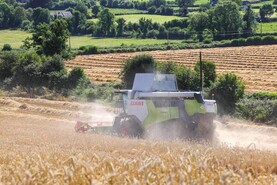Straw imports into the country in the first half of 2024 have increased as the cereal area has declined.
Imports of straw into the Republic of Ireland from January to June are already 46% (4,800t) ahead of total straw imports for 2023 at 15,219t.
That’s the equivalent of over 100,000 round 4X4 bales or over 27,000 8X4X4 square bales.
Figures from the Central Statistics Office (CSO) show that a total of 10,436t of straw was imported in 2023.
The majority of this straw came from Britain at 12,751t, while 1,491t came from Northern Ireland.
CSO figures also show almost 500t from Lithuania, 251t from Spain and 82t came from unknown destinations.
Germany, Belgium, the Netherlands, India and Italy were all reported on the imports list with small amounts each.
In 2023, the main countries listed by the CSO for straw imports were Northern Ireland (3,720t), Spain (2,557t), Lithuania (2,082t), Britain (1,1246t), Germany (264t), Belgium (254t) and small amounts from Austria and Denmark.
The increase in straw imports coincides with a decline in the winter barley, wheat and oats area in Ireland of over 23,000ha in 2024, which are high-yielding crops, and a total decline in winter and spring cereal area of almost 7,400ha (3%).
In 2023, that area declined by 6%.
The vast range of countries where straw is coming from throws up many questions in relation to biosecurity and the entrance of invasive weed species into the country.
The CSO describes straw as cereal straw and husks, unprepared, whether or not chopped, ground, pressed or in the form of pellets.
Prices
Meanwhile straw prices are holding at €28-32 for 4x4bales of barley straw ex-field, with up to €35/bale being sought in some areas.
Up €60-70/bale ex-field is being paid for to 8x4x3 bales of barley straw, with €80-90 being quoted for 8x4x4 bales.
Prices are holding on the back of mixed straw yields from the spring barley crop.






 This is a subscriber-only article
This is a subscriber-only article










SHARING OPTIONS: